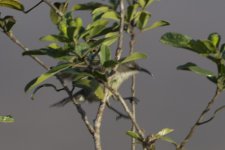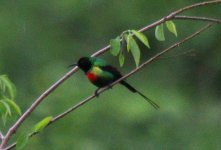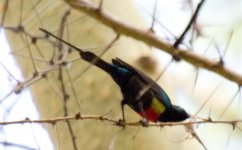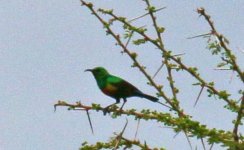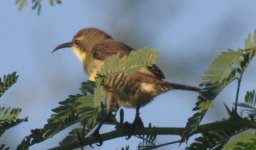Hi Valéry:
As a result of your post, I did some research in my Africa books and on Handbook of Birds of the World (HBW; those of you who don't have a subscription will not be able to check this, unfortuately) and Avibase.
The following remarks leave aside the identity of the OP's bird (for the time being) and focus on the distribution of Beautiful Sunbird.
I know full well that you are infinitely more knowledgeable than me on African (and all other) birds. However, from my research, it seems you are mixing up two different things in your comment.
All of my books (Stevenson and Fanshawe, Zimmerman, and Sinclair and Ryan) show the distribution of Beautiful Sunbird covering the Lumo Community Area where the OP took his photo.
The books mention that there are two sub-species, the nominate, Cinnyris pulchella pulchella, and C. p. melanogaster. Both show broad yellow patches on the sides of the chest, but the nominate has a green and black belly, while melanogster (which, of course, means dark belly) has an all black belly. C. p. melanogaster would be the sub-species which occurs in Lumo and further south.
However, Black-bellied Sunbird is another bird altogether, Cinnyris nectarinoides, with two subspecies, northern and southern. This bird looks similar to Beautiful, and may show yellow pectoral tufts, but
not the large yellow patches of both sub-species of Beautiful. I think Black-bellied could also be found at Lumo, looking at distribution maps.
I wonder if the 'long time ago' you mention refers to the splitting of the genus Nectarinia when the Cinnyris genus was made?
Now, looking at HBW and Birdlife, the distribution maps for Beautiful (which you linked to) indeed do not include Lumo or south-east Kenya or Tanzania. The reason is that HBW and Birdlife - but so far as I can see from
Avibase, not any other authority, including the IOC - two years ago, decided to split C. p. melanogaster as C. melanogaster with the name 'Gorgeous Sunbird' (which isn't in the books because it's a new split not widely recognised, but which is in HBW because they invented it).
And I far as I can see the females of the two (sub-)species look the same.
I attach some photos.
1. nominate male Beautiful from Bogoria (note the green belly sides)
2. melanogaster / Gorgeous male from Amboseli (note the all black belly
3. melanogaster / Gorgeous male from Ngorongoro
4. the female that was with the Bogoria male (I don't have females from the other places)
To return to the ID of the OP's bird: to my eye, the female in my photo 4 looks like a match for the OP's bird. Note the overall colour, the 'dot' not stripe above the eye, and the form of the bill.
As I said in my previous post, location was part of the ID. Looking at Stevenson and Fanshawe, I think the only female sunbirds with this basic shape (including the bill) and unstreaked underparts in this location apart from C. p. melanogaster / Gorgeous are Variable, Olive, and Eastern Double-collared. I think the colouration is slightly wrong for these others, but I'm willing to be corrected.
My main point in this post is to clarify the Beautiful / melanogaster / Black-bellied trio for myself, the OP and anyone else who might be reading.
I'm not at all
insisting on C. p. melanogaster female for the OP's picture, but I've given the reasons why I would go for that ID. I don't think it's such a bad picture that it can't be identified, partly because, to repeat, there aren't that many possibilities in that location. It would be interesting if the OP could tell us any male sunbirds he saw in the Lumo area. I'd be interested to have Valéry give his best ID.




